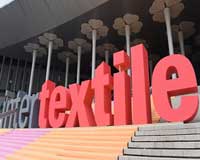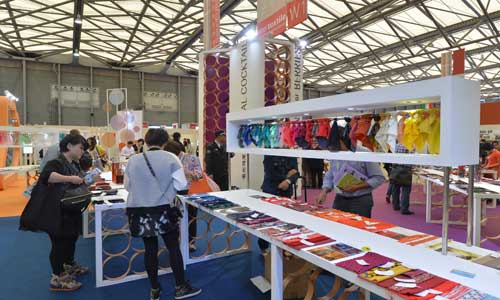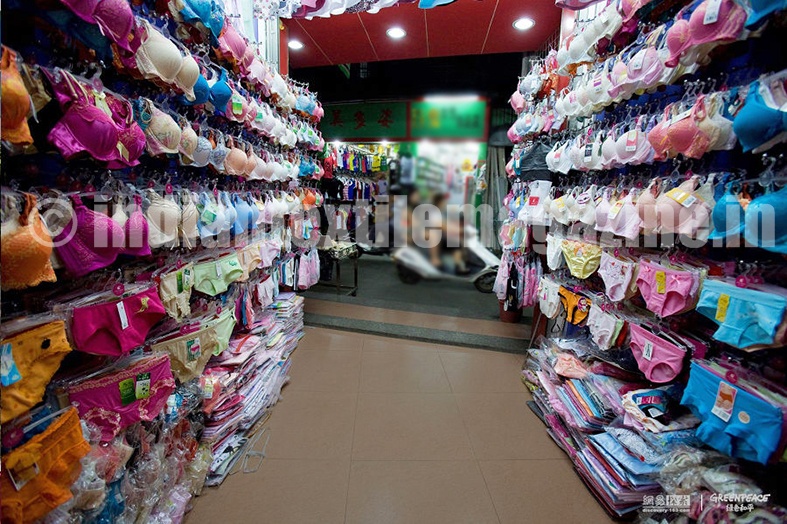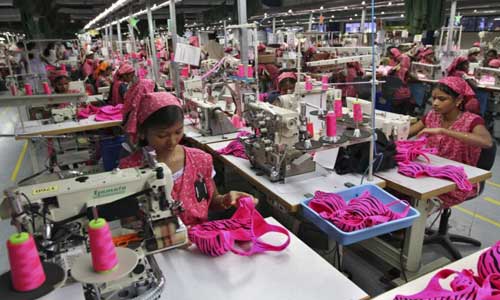FW
"The upcoming Intertextile Shanghai Apparel Fabrics which opens on October 11, will be the perfect platform for sustainable paradigms and companies. The centre of sustainability at the three-day fair will be the All About Sustainability zone (hall 5.2), but eco-friendly products and companies will also abound in Beyond Denim (7.2), Functional Lab (5.2), SalonEurope (6.2) and Accessories Vision (4.2) to name just a few. At Beyond Denim, Orta Anadolu, Kipas Denim and Soorty Enterprises will introduce their eco-friendly denim production processes."

The upcoming Intertextile Shanghai Apparel Fabrics which opens on October 11, will be the perfect platform for sustainable paradigms and companies. The centre of sustainability at the three-day fair will be the All About Sustainability zone (hall 5.2), but eco-friendly products and companies will also abound in Beyond Denim (7.2), Functional Lab (5.2), SalonEurope (6.2) and Accessories Vision (4.2) to name just a few. At Beyond Denim, Orta Anadolu, Kipas Denim and Soorty Enterprises will introduce their eco-friendly denim production processes. In the Functional Lab, exhibitors will offer innovative and sustainable products. For example, The Chemours Company’s durable water repellent, which contains 63 per cent renewably sourced content, and Singtex with their insulation foam and membrane made from coffee oil extracted from used coffee grounds.
New products and technology

As a hub of innovation for the global apparel fabrics and accessories industry, buyers will witness numerous fine examples of sustainable products. For instance, Japanese firm Yagi & Co will showcase new Recycolor-branded, GRS-certified recycled cotton. Recycolor cotton is made from old clothing and scraps from garment factories, which are sorted by colour and fed into stripping machines that break the fabric down into their original fibres. As these fibres are usually too short to spin, they are then mixed with virgin cotton and undergo a special spinning technique to create a yarn up to commercial standards.
Debut exhibitors
A debutant to the fair, Chinese company Newtech Textile, will showcase its patented Cooltrans transfer printing and dyeing technology, an eco-friendly alternative to digital inkjet printing. Compared to conventional printing technologies, Cooltrans reduces water and dye consumption by 40 per cent and 67 per cent respectively, while 92 per cent of water can be reused. It also reduces energy usage by up to 65 per cent thanks to a cooler transfer temperature, and features rates of 95 per cent for dye transfer and 95 per cent for dye-fixing. In addition to the environmental aspects of the technology, it also offers higher colour yields and more delicate printing on the transfer paper or file than direct textile inkjet printing.
Oeko-Tex by Testex Pavilion will feature 10 Standard 100 by Oeko-Tex-certified companies and customers of Testex. The pavilion’s product range includes knitted and woven fabrics made of natural fibres, chemical fibres, and mixed and microfibre functional fabrics, as well as accessories such as embroidery thread, labels, RFID tags and more. There are some new members such as Sateri, who is a global leader in viscose rayon, as well as Malaysia’s Penfabric, a member of the Toray Group, which is also Step certified, while its semi-finished products are Made in Green by Oeko-Tex labelled. Furthermore, the Made in Green/Step by Oeko-Tex Shop will feature 17 Step-certified companies showcasing their textiles made in environmentally friendly facilities and safe and socially responsible workplaces.
Debut Ecocert Pavilion
The Ecocert Pavilion will debut at this year’s edition. Two members of the pavilion include Shaoxing Ecou Textile which specialises in organic cotton & linen, bamboo, Tencel, Modal and hemp fabrics, while Chifeng Dongrong Cashmere Development will showcase a wide range of sustainable cashmere products.
Panel discussions
This three-day event will also host panel discussions on Sustainable Fast Fashion (Forum Space, hall 5.2) – moderated by Redress, and panellists include the Sustainable Apparel Coalition and DuPont; Sustainable Denim – a holistic approach (Beyond Denim Forum, hall 7.2): moderated by Archroma, and panellists include Advance Denim and others; and Organic Cotton Trends & Certification (Forum Space, hall 5.2) – moderated by Beijing Ecocert Certification, and panellist include GOTS, Chifeng Dongrong Cashmere Development and Shaoxing Ecou Textile.

The innerwear market in India is segmented between men and the more fancy-driven women’s and both markets are growing significantly. While the global men’s innerwear segment is estimated to grow at a CAGR of 5.8 per cent to reach $13.6 billion by the end of 2024, women’s innerwear is projected to grow at a CAGR of 6.4 per cent to reach $55.83 billion by the end of 2024. Growth is boosted by organised retail penetration and increase in monobrand and multibrand outlets. But Indian manufacturers are not able to capture its true potential. The segment is growing at an estimated CAGR of 12.2 per cent.
Latent potential

A recent report by Intimate Apparel Association of India and Wazir Advisors estimates the underwear market at nearly Rs 24,000 crores and expected to touch Rs 47,000 crores, which is nearly 8 per cent of the total estimated apparel market by 2020. The men’s underwear market is currently valued at around Rs 8,500 crore. With increasing disposable income and changing attitudes towards the category, the segment is expected to reach Rs16, 500 crores by 2020.
While many companies are setting their base in this burgeoning market, the industry is still rife with challenges. Sanjay K Jain, MD, TT, feels undergarments export is increasing but at a small pace. Innerwear market will grow consistently, and the biggest opportunity is going to come from unorganised market shifting to branded players. Growth would be coming from market expansion and shift.
Yusuf Dohadwala, CEO, Intimate Apparel Association of India (IAAI), claims the overall Indian intimate wear industry is witnessing the fastest Y-o-Y growth which is estimated at 18-20 per cent and this growth is the highest in the world. One of the reasons for this growth is underwear is a basic necessity. This makes it almost recession proof with minimal effect from negative market trends. Although according to Jain, due to psychological impact and pipeline inventory, the Indian innerwear industry faced short-term recession due to demonetization and GST. For Dohadwala, things are fast changing in India with consumers getting more evolved. Fashionable intimate wear is rapidly growing and taking large space in wardrobes especially for women’s category.
Exports growth concerns
Brandix, Quantum Clothing, Seeds Intimate Apparel, Pratibha Syntex, Eastman Exports Global Clothing, etc, are some companies involved in intimate wear exports. While there are others who have the capacity to be enabling exporting companies but they aren’t ready to take the route. And as Jain points out overall competitiveness in India is an issue due to unfavourable FTAs and bilateral agreements vis-à-vis competitors like Bangladesh, Vietnam, Cambodia etc. Hence, exports are mainly limited to the Middle East and African nations, further domestic brands need to be more organised and integrated to cater to the US and Europe in a bigger way. He says both domestic and exports have enough scope but export growth would somehow depend on government policy and support.
The domestic market has over 1,000 innerwear lables. Exports from India is low but growing. However, the industry has to work at poor skills in manufacturing of value-added products or fashionable products. Therefore, at present, we can export only basics. For value-added products, India is unable to meet the efficiencies found in China, Bangladesh, Sri Lanka, Vietnam, Cambodia, Indonesia. To be competitive, it is important to have raw material base in India, especially for lingerie segment, which is low. Hence, to export, we would have to depend on China for raw materials, increasing the lead time and which is why buyers don’t aim at sourcing from India.
B Naveen, MD, BSCI certified Clifton Export, opines the only benefit of undergarment manufacturing is one does business throughout the year but the margins are low compared to other garments product and more price-competitive. Besides, one needs specialised machines and in-house elastic manufacturing without which producing undergarments would become difficult. He further added in the last four years, Bangladesh has increased its focus on undergarment business which is again a big challenge for players like him.
Cotton Council International (CCI) is organizing a seminar in Coimbatore, September 23, 2017. It will offer insights on the present scenario of US cotton and global cotton supply and demand. The seminar would give a brief introduction to US cotton industry and present why the world trusts US cotton. CCI would also be sharing the US cotton industry’s sustainability efforts and research findings from recent market and consumer studies.
There will be updates on global cotton production, demand, exports and import trends. India is the biggest consumer of Supima. This is a special extra-long staple fiber grown in California, Arizona, New Mexico and Texas. It’s known for its softness, strength, brilliance and lasting colors.
Recently India has seen an increase in the import of raw cotton, especially US cotton. Indian mills have shown a preference for US cotton demonstrated by importing more than a million bales of US cotton for the marketing year 2016-17. Cotton Council International is a non-profit that promotes US cotton fiber and manufactured cotton products around the globe with its Cotton USA mark. Its reach extends to more than 50 countries through 20 offices around the world. CCI’s mission is to make US cotton the preferred fiber for mills and manufacturers, brands and retailers and consumers.
Welspun has been awarded a Made In Green label by Oeko-Tex. This is a traceable consumer sustainability label that indicates that textiles have been tested for harmful substances and manufactured in environmentally and socially responsible facilities. Welspun, a manufacturer of home textiles, is the first Indian manufacturer to be awarded the Oeko-Tex for bed and bath textile products.
To qualify for the label, Welspun products underwent independent testing which verified the textiles are free from dangerous levels of chemical substances. In addition, Welspun facilities were evaluated and certified to the STeP by Oeko-Tex standard that confirms that manufacturing processes comply with multiple guidelines for sustainable textile production.
Made In Green is a label that is traceable and transparent. Consumers can enter a product’s unique ID code on the Made In Green website or scan the label’s QR code with their smart phones. These links will quickly authenticate the label, an important benefit for busy shoppers, and provide visibility into every component of the production stream.
The label supports retailers in their efforts to offer more sustainable products to consumers. The label clearly and quickly communicates to shoppers that the products have been tested for harmful substances and made with respect for employees, communities, and the planet.
A conference on Research, Innovation and Science for Engineered Fabrics (RISE) was held in the US from September 12 to 14, 2017. The theme centered around nonwovens and engineered fabrics. Technology scouts and product developers who attended left fortified with valuable solutions, new ideas and connections.
The conference attracted over 140 technical professionals, industry experts, scientists and R&D specialists who discussed on leading-edge topics in future manufacturing, moisture management, 3-D nonwoven structures, wet laid nonwovens, advanced materials, biomaterials, machinery, corporate R&D hurdles and other topics.
RISE is a technical conference where product developers and nonwovens scientists came together in one place to share their innovation stories. The balanced number of researchers from academia and industry created a good mix of applied research and fundamental science-based knowledge. Visitors were updated on major research trends and directions.
Whether one was looking for high tech materials, such as programmable fabrics, or potential sustainable solutions to meet customer needs and organizational targets, RISE offered new thinking.
The RISE poster session offered industry professionals an excellent opportunity to meet over 20 talented graduate students and explore new processes, structures, coatings, polymers, and applications in their poster presentations.
Presentations that inspired new ideas included such concepts as trending patent indicators in higher loft nonwovens and transforming fibers into devices for fabric applications in audio and social media.
Texworld is being held in France, September 18 to 21. This year the event sees the debut of Texworld Denim. Around 60 global manufacturers specializing in denim are displaying their products. Out of these, 47 are from China, six from Pakistan, three from India, one from Bangladesh and one from Canada.
Texworld and Apparel Sourcing Paris have always had denim and jeans manufacturers in past editions. In past seasons, the show hosted some jeans and denim manufacturers but they were scattered. This time, the organizers decided to merge exhibitors from Texworld denim segment, mostly offering fabrics, with those from Apparel Sourcing pavilion, specializing in garment manufacturing. In order to help visitors find denim specialists faster, they named it Texworld Denim.
The new section will host a Social Village, an area presenting a trend forum and including an area for conferences where industry insiders will have the opportunity to discuss the hottest topics. A catwalk show will present the best products from exhibitors.
Texworld features international manufacturers specialising in fabrics, trimmings and accessories. Over 100 exhibitors will be coming to Texworld to attend the show for the very first time. South Korea, Thailand, Pakistan and India will again offer pavilions with more than 20 exhibitors.
Textile Asia held in Pakistan from September 16 to 18, 2017 saw numerous orders and MoUs signed for investment in Pakistan through joint ventures with local companies. Around 52,000 trade visitors registered their presence at the textile fair. The machinery and equipment displayed at the exhibition were of immense utility to manufacturers producing value added products for increasing the volume of exports. Local businessmen are expected to benefit from this technology by adding value to their products.
Textile Asia also featured businessmen to businessmen meetings, many industry-related presentations and seminars on the textile sector. The textile sector’s whole chain was invited to attend the largest textile show to be held in Pakistan. Exhibiting countries included Austria, China, Czech Republic, France, Germany, India, Italy, Korea, Taiwan, Turkey, UK, USA etc.
The exhibition was aimed at focusing on the textile industry of Punjab, the potential of its textile and garment machinery, accessories, raw material supplies, chemicals and allied services. Around 80 per cent of Pakistan’s textile industry is located in this province. The exhibition also provided an effective platform for joint ventures and collaborations for small and medium units in the textile sector.
Textile Asia was organized by the Pakistan Readymade Garments Manufacturers and Exporters Association (PRGMEA) and E-Commerce Gateway Pakistan.
Orissa has vast potential for mulberry and eri silks. Both can be promoted in coastal areas. As of now, Orissa is a predominately tussar producing state as its rich endowment of forest, east coast and tribal population enhance agro-climatic conditions for turras forestry. As many as 20,000 tribal families in the state are practicing sericulture, of which more than 16,000 are tussar farmers and 500 mulberry farmers. About 90 per cent of the total silk produced in Orissa is from tasar. Of 125 tons of silk produced in the state last year, 115 tones was of tussar silk. Mayurbhanj, Keonjhar and Sundargarh are the three major turssar producing districts as those contribute 90 per cent of the tasar silk production in the state.
While Karnataka is producing 60 per cent of the mulberry, Tamil Nadu, Andhra Pradesh and Maharashtra contribute 10 per cent each and the rest is contributed by Orissa, Jharkhand, Bihar, West Bengal and other states. Since Orissa is now getting the basic eri seed from Assam and Tamil Nadu, a seed farm will be opened at Koraput. Two clusters will focus more on increasing production of mulberry. Farmers are being encouraged to go for more mulberry farming as it is priced high compared to other silks available in the country.
Going ahead with its corporate sustainability plan to reduce its carbon footprint Nike has announced the launch of Flyleather, a new leather material made from leather scraps. Hannah Jones, Nike Chief Sustainability Officer and VP of the Innovation Accelerator one of the greatest opportunities is to create breakthrough products while protecting our planet.
Flyleather reduces waste in leather manufacturing. In traditional leather processes, up to 30 percent of the cow's hide is thrown away. Similar to Nike's campaign in the 90s to recycle rubber from old sneaker soles, Nike has now gone to tanneries and gathered up their scraps to make a new fabric. Flyleather uses 50 per cent genuine leather and its hand feel can mimic the touch and fit of athletic leather, reminiscent of old basketball shoes. Nike fuses the scraps with synthetic fibers to create a new material that can be dyed and put on a roll to be cut like pleather.
Tony Bignell, Nike VP of Footwear Innovation says unlike with traditional leathers, Flyleather can be produced with a consistent grade across a broader range of product. Since the material is produced on a roll it can be used like a cut-and-sew fabric that maximizes yield and minimizes waste. From a sustainability standpoint, the Flyleather uses 80 to 90 percent less water than traditional leather and has half the carbon footprint.
The new fabric is 40 percent lighter than traditional leather and five times more durable than real leather in abrasion tests. Nike foresees using Flyleather in apparel and accessories as well as across multiple sport categories. The first Flyleather product called the Nike Flyleather Tennis Classic is now available at Nike's 21 Mercer, the Nike SoHo store and Dover street market in New York City.
The used look on denim garments is produced using potassium permanganate. However, potassium permanganate as a substance is particularly dangerous to the environment. It contains manganese, a heavy metal and not biodegradable. The CHT Group now presents OrganIQ Bleach an ecological alternative to potassium permanganate. This is an organic bleaching agent, free from heavy metals and chlorine and completely biodegradable. OrganIQ Bleach doesn’t contain persistent substances. Compared to potassium permanganate and chlorine bleach, neutralisation is not needed, just rinsing at the end of the process. The waste water is not polluted with toxic substances.
OrganIQ Bleach has excellent ecological bleaching properties and a good reproducibility. Technicians and designers from famous brands consider it to be even better, cleaner and with more contrasts than potassium permanganate. The slower reaction speed of OrganIQ Bleach compared with potassium permanganate and chlorine proves to be particularly decisive for getting a really sensational bleaching result. After all, it is especially this property that allows for achieving excellent, reproducible bleaching results while making enormous savings in water, time and energy.
Treatment does not take longer than a common stonewash but less subsequent steps are required. Average pick-up of garments is 25 per cent and there is practically no risk of damage to stretch denim.











